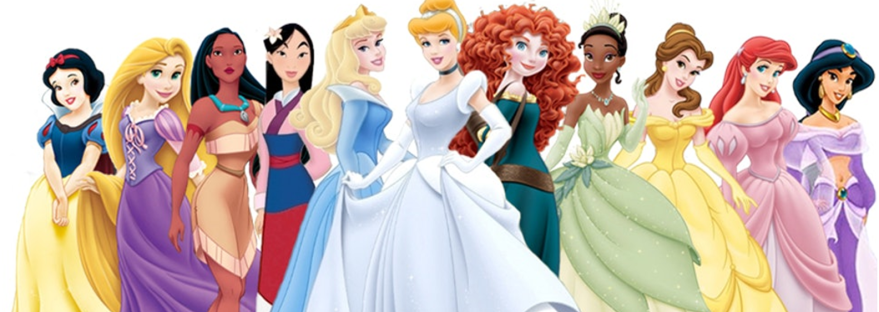During his review of Snow White, Ben questioned my integrity as a self-proclaimed feminist. Looking at the film from a newbie’s perspective in 2020, as opposed to someone that had watched it since they were approximately four-years-old, he does have a fair point. Let’s look at the evidence against the film from a pro feminist standpoint (and standby, there’s a fair bit). However, before we go any further, I just want to address the fact that I, personally, wouldn’t actually refer to myself as a ‘feminist’ but more of an ‘equalist’. Still, for the purpose of taking a polarised view of the film, I will take the role of ‘feminist’ today.
The film starts with the evil queen asking a mirror whether she is the fairest of the all:
Anti-Feminism Point 1 (AFP1) – The most important concern a woman really has is how physically attractive she is.
She asks this question to a magic mirror, who’s image and voice is clearly male:
AFP2 – Only a male can define a female’s beauty
The mirror tells her that, though previously she held the title, it is now her step-daughter, Snow White’ that is the fairest of them all:
AFP3 – As a woman, once you reach a certain age, you aren’t beautiful anymore. Also, be greatly fearful of younger women. They are a huge threat!
The next scene is of Snow White, dressed in rags (which is never really explained, other than through our assumptions that her paranoid step-mother makes her wear them to try and stop her looking so attractive), singing happily in a courtyard. Nothing too bad here, I guess (except the horrible pitch of her singing voice, but Ben addressed that). Then a prince arrives, serenades her with a song and they seem to instantly fall in love at first sight.
AFP4 – For a women to attract a man, she just needs to look nice (and sing).
AFP5 – For a man to attract a woman, he must merely exist and show some interest (and sing).
We then go back to the Queen, who has concluded that Snow White has got to go and has ordered a huntsman to take her into the forest and kill her.
AFP6 – Women are bitter and jealous of each other and will literally kill to get to the top.
From my experience, this isn’t far from the truth. #notallwomen
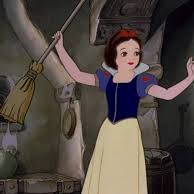 The huntsman takes Snow White into the woods, but finds her so lovely, that he can’t kill her. I could go for a AFP7 here (being pretty gets you out of anything) but ultimately, she is lovely and he doesn’t want to kill her for that reason. Fair enough. So he tells her what the Queen had ordered him to do and that she needs to run away and never return. Which she does. She comes across a little cottage in the forest, lets herself in, sees it’s filthy and wonders where the woman is to clean the house.
The huntsman takes Snow White into the woods, but finds her so lovely, that he can’t kill her. I could go for a AFP7 here (being pretty gets you out of anything) but ultimately, she is lovely and he doesn’t want to kill her for that reason. Fair enough. So he tells her what the Queen had ordered him to do and that she needs to run away and never return. Which she does. She comes across a little cottage in the forest, lets herself in, sees it’s filthy and wonders where the woman is to clean the house.
AFP7 – (I don’t even need to try with this one, do I) Women should be the only one’s that clean… anything… ever.
She then sets to cleaning the house.
AFP8 – Women can’t have things untidy and just have to clean if something is dirty.
We then cut to the dwarves in the diamond mine finishing up from their hard day of work and they head home. In the meantime, Snow White has decided to have a nap over three of their beds. Unsurprisingly, they are shocked to find their house clean when they get home and conclude that a monster must be in the house (????)….. stuff happens, but nothing happens in relation to AFPs. Let’s skip ahead.
The Queen has found out that Snow White isn’t actually dead and has poisoned an apple to trick her into eating, which will send into a sleep so deep, that others will think she’s dead. In order to trick SW, the Queen has also disguised herself as an old hag. The next day, the dwarves head off to work, but not before telling Snow White to not leave the house and not answer the door to anyone, as it could be the witch in disguise. Long story short, it doesn’t take a lot of convincing from the Queen to trick Snow White and she eats the poisoned apple.
AFP9 – Women are really stupid and you cannot trust them to look after themselves.
Dwarves find her, think she’s dead, put her in a glass coffin. Several months later (with no question from dwarves as to why she hasn’t decomposed at all), the same Prince rocks up and kisses her ‘corpse’. She wakes up, kiss and they ride off into the sunset to live happily ever after!
AFP10 – Women need to be rescued by men.
AFP11 – Women have no other aspirations in life, other than to get married. She’s 14! So, looking at the era the film is set in, she’s probably got another 50-60 years to live. What is she going to do in that time? Probably have some children, as that is another one of the few things that women aspire to do, apparently (I have 2 children, so no judgement from me, but it’s not exactly something that all women must aspire to do with their lives), but after that, what? She better get good at needlepoint!
So, Snow White. Not exactly a suitable example of feminism, is it. However, in it’s defence, the film was made in in 1937 and, at that time, that was the norm’ for women and men.
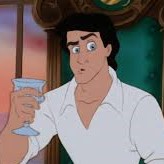 Now, I feel it would be unfair to men if I didn’t point our a few ‘anti-man’ points in that film. Specifically in relation to the dwarves. The implication that men living alone never clean their homes, as pretty unfair. That men living alone don’t clean themselves is quite unfair! Not to mention, that 7 adult men thought that there was actually a monster in their house, is making men look just as stupid as women are implied to be… but that’s it. Bearing in mind that this film was mostly likely marketed towards little girls, it does make women look rather pointless and stupid.
Now, I feel it would be unfair to men if I didn’t point our a few ‘anti-man’ points in that film. Specifically in relation to the dwarves. The implication that men living alone never clean their homes, as pretty unfair. That men living alone don’t clean themselves is quite unfair! Not to mention, that 7 adult men thought that there was actually a monster in their house, is making men look just as stupid as women are implied to be… but that’s it. Bearing in mind that this film was mostly likely marketed towards little girls, it does make women look rather pointless and stupid.
Disney ‘princesses’ followed this pattern with a few of the earlier films. Cinderella, Sleeping Beauty and my beloved Little Mermaid all followed the ‘young woman waiting to be rescued by a man’ premise. Then, in 1991 (54 years after Snow White) the release of Disney’s adaptation of the Gabrielle-Suzanne de Villeneuve classic, Beauty and the Beast (La Belle et la Bête) commenced a change in the previously anti-feminist narrative of the Disney Princess film. The protagonist, Belle, is not in the slightest bit interested in finding a husband, with a real passion for literature and seeing the world. Finally, an ideal role model for the modern girl, you could say. However, it is made clear that this lack of wanting to marry, and her obvious intellect, results in the townspeople expressing that she is ‘strange’, ‘peculiar’ and ‘a beautiful but funny girl’. Disney are providing us with a young woman that neither wants nor needs to be rescued but are, arguably, at the same time pointing out that if you want to be like her, expect to be seen as a 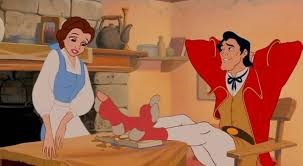 social pariah of sorts. Of course she then goes on to get Stockholm Syndrome. That will teach her for thinking she doesn’t need a man! If you’d let that lovely ‘Alpha Male’ Gaston marry you, you never would’ve ended up locked in a castle by a beast. So not sure if Beauty and the Beast really is that pro-feminist if we break it down.
social pariah of sorts. Of course she then goes on to get Stockholm Syndrome. That will teach her for thinking she doesn’t need a man! If you’d let that lovely ‘Alpha Male’ Gaston marry you, you never would’ve ended up locked in a castle by a beast. So not sure if Beauty and the Beast really is that pro-feminist if we break it down.
Let’s move on to our next potential feminist ‘princess’. Jasmine. Ok we have a little bit to work with here. Obviously she is a lot more of an icon in the recent live-action Aladdin, but if we are purely focussing on the animated version… I suppose you could say that it is a feminist move to not agree to an arranged marriage but, if I’m honest, certain cultures throughout the world in 2020 don’t allow women to have the ability to decline who they are betrothed to. I wouldn’t say that this is a specifically feminist move, but more of an ‘entitled princess’ move. A girl in not so prominent a position wouldn’t dare challenge their father for deciding who they marry, as their lives would most likely be at risk for such a brazen mark of disrespect towards the patriarch of their family. So, no, Jasmine is not a feminist ‘princess’ (and, essentially, still gets ‘rescued’ by Aladdin).
Pocohontas. Daughter of the Chief of a Native American Tribe. Again, we have a young woman who’s father has plans for her to marry a man of his choosing. She defiantly falls in love with a white, British man. There’s nothing standing out that make’s Pocohontas a feminist role-model (however, obviously comment below if you can think of something she does that goes against her gender stereotype).
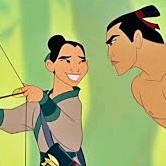 Now we are on to Mulan. One male from every Chinese household must go and fight in the war against the Hun army. As Mulan’s father is elderly and she has no brothers, she dresses as a man and goes off to fight in her father’s place. Total badass feminist, this one. In fact, I would say Mulan was the first official feminist role-model in a Disney Princess film. The only thing that takes anything away from that is that they still feel she needs a love interest (and a strapping Alpha love interest, at that). I don’t have a problem with characters having love interests, I just don’t feel that it is relevant to the story or adds anything to it. Still, Disney has definitely started heading in the right direction and we applaud that!
Now we are on to Mulan. One male from every Chinese household must go and fight in the war against the Hun army. As Mulan’s father is elderly and she has no brothers, she dresses as a man and goes off to fight in her father’s place. Total badass feminist, this one. In fact, I would say Mulan was the first official feminist role-model in a Disney Princess film. The only thing that takes anything away from that is that they still feel she needs a love interest (and a strapping Alpha love interest, at that). I don’t have a problem with characters having love interests, I just don’t feel that it is relevant to the story or adds anything to it. Still, Disney has definitely started heading in the right direction and we applaud that!
Following Mulan, I believe that Disney has continued well with it’s princesses becoming stronger and stronger feminist icons for today’s much more equality-driven generations.
- Tiana (The Princess and the Frog, 2009) is an ambitious waitress who hopes to open her own restaurant. A potential future entrepreneur. The requirement for a love interest is unavoidable due to the entire point of the film (otherwise the film would just be called ‘The Waitress’ and that’s not much of a fairy tale is it… unless that IS a fairy tale for you. Who am I to judge your life’s ambitions!? You do you!), so as progressive characters go, she’s as good a role model as she can They did well.
- Rapunzel (Tangled, 2010), a stolen princess with magical powers, able to restore youth. Now we are taking a possible backwards step a little here, with Mother Gothel’s obsession with staying young. Just like with Snow White’s stepmother, it may be slightly leaning onto the ‘keep young and beautiful if you want to be loved’ narrative, but I reckon Mother Gothel’s reasoning is more along the lines of a fear of death, rather than of staying young and therefore beautiful. I don’t know for sure, as her motivation isn’t as clear as The Evil Queen’s in Snow White, but we’ll give her the benefit of the doubt. Arguably, Rapunzel get’s saved by a man, but does she really? She wants to leave the tower and could’ve left at any time, were it not for years of hardcore emotional manipulation by her ‘Mother’. Besides, she handles herself very well (don’t tell a woman to get back in the kitchen, as those cooking tools can double well as weapons, boys) when an intruder (Flynn Ryder) gets into the tower, not to mention the many scrapes she get’s them out of! The ultimate comes at the end of the film when we are told, by Eugene (Flynn), that Rapunzel has proposed to him. That’s our girl!
- Merida (Brave, 2012) straight up refuses to follow the path that has been decided for her, by her parents (particularly her mother) to marry the eldest son of one of the neighbouring clans. Merida is the ultimate ‘tomboy’ with a love (and strong aptitude) for archery and being in the outdoors. By the end of the film she has bonded with her mother and has managed to get the ‘betrothal’ tradition changed.
- Anna and Elsa (Frozen, 2014). From the offset, Anna doesn’t appear to be so obvious a feminist icon, in the sense that she falls very quickly in love with the first man that shows her any interest (but, hey, who didn’t do that in their teens, amirite!), but she is in the way that her character is clumsy (not the graceful ‘princess’ of yester-Disney-year) and that she is extremely brave. When Elsa accidently freezes Arendelle and exiles herself to the North Mountain, Anna has no hesitation when she heads off, by herself, to find her sister and bring her home. She does meet Kristoff on her journey, but other than providing transport, Anna does all the ‘heavy lifting’ on the mission. Elsa is the first Disney princess (although, is actually the only Disney Queen in the franchise) that doesn’t have a love interest at all! No betrothals, no guy trying to catch her eye (or girl for that matter, but I’ll be addressing that in a future post). She is the epitome of a strong independent woman that don’t need no man. This is huge for Disney and, in my opinion, probably the biggest step that they took in their feminist evolution, which leads me on to our final ‘princess’…
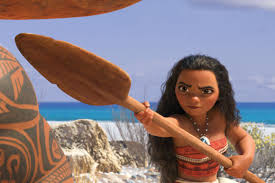 Moana (… well, ‘Moana’, 2016). The daughter of the chief of a Polynesian island nation, she will be inheriting the title no matter what and is being taught the ropes by her parents. When it becomes clear that a curse, caused by the theft of ‘the heart of Te Fiti’ by a demigod named Maui, is causing the island to essentially die, Moana sets off to sea, to find Maui and return the heart of Te Fiti.
Moana (… well, ‘Moana’, 2016). The daughter of the chief of a Polynesian island nation, she will be inheriting the title no matter what and is being taught the ropes by her parents. When it becomes clear that a curse, caused by the theft of ‘the heart of Te Fiti’ by a demigod named Maui, is causing the island to essentially die, Moana sets off to sea, to find Maui and return the heart of Te Fiti.
With their more recent offerings, I feel that Disney have really taken huge strides in creating more positive role models for girls. It is truly an evolution of feminism, but I do want to point out that Snow White was released and 1937 and Mulan in 1998. It took them 61 years to give us a ‘princess’ that didn’t need to be rescued (although let’s not ignore the fact that the feminist movement didn’t even start till the 1960’s, so that’s 3 princesses we could discount from this whole argument, in reality). However, since then, they have given us 6 ‘sisters doing for themselves’ in only 20 years.
So I truly believe that Disney are a progressive company, with regards to feminism. Are they progressive in other areas, in particular with regards to race and LGBTQ+ issues? Keep checking Disney Guide For the Misguided for posts on these topics in the near future.
As always, please comment below with any points or opinions that you have on this topic (or just to say that I’m a social justice warrior who should get back in the kitchen, if you just have to get that off your chest!)
Kerry 😁

